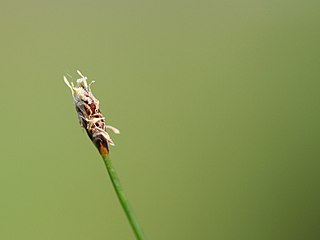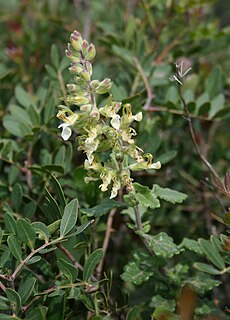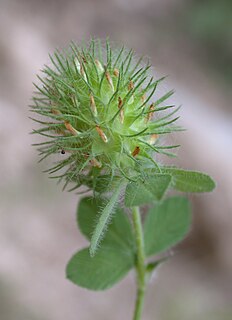
Eleocharis is a virtually cosmopolitan genus of 250 or more species of flowering plants in the sedge family, Cyperaceae. The name is derived from the Greek words ἕλειος (heleios), meaning "marsh dweller," and χάρις (charis), meaning "grace." Members of the genus are known commonly as spikerushes or spikesedges. The genus has a geographically cosmopolitan distribution, with centers of diversity in the Amazon Rainforest and adjacent eastern slopes of the South American Andes, northern Australia, eastern North America, California, Southern Africa, and subtropical Asia. The vast majority of Eleocharis species grow in aquatic or mesic habitats from sea level to higher than 5,000 meters in elevation.

Eleocharis acicularis is a species of spikesedge known by the common names needle spikerush and least spikerush. It is widespread across Europe, central and southeastern Asia, North America and northeastern South America as far south as Ecuador. It is also found in Australia, where it is probably an introduced species.

Eleocharis macrostachya is a species of spikesedge known by the common name pale spikerush.

Eleocharis palustris, the common spike-rush, creeping spike-rush or marsh spike-rush, is a species of mat-forming perennial flowering plants in the sedge family Cyperaceae. It grows in wetlands in Europe, North Africa, northern and central Asia and North America. Eleocharis palustris is not easily distinguished from other closely related species and is extremely variable worldwide itself. The species epithet palustris is Latin for "of the marsh" and indicates its common habitat.
Eleocharis halophila, the saltmarsh spikerush, is a perennial halophytic plant endemic to salt marshes in eastern Canada, in Ontario in Hudson Bay and James Bay, Quebec in the St. Lawrence Seaway as far as the city of Quebec, Newfoundland and Nova Scotia and in the United States from Maine to North Carolina. It is one of 76 species of Eleocharis amongst the 36 genera in the sedge family (Cyperaceae).

Eleocharis nitida is a species of flowering plant commonly called neat spikerush, it is a member of the sedge family Cyperaceae.

Eleocharis flavescens is a perennial flowering plant species called bright green spikerush, pale spike-rush, or wrinkle-sheathed spike-rush; it is a type of spikerushes belonging to Juncaceae. It is clump-forming species that also spreads into colonies. It is a small species that looks similar to other Spikerush species. It is native to temperate North America, the West Indies, and South America.
Astragalus boeticus is a species of annual herb in the family Fabaceae. They have a self-supporting growth form and compound, broad leaves.
Callitriche truncata is a species of tree in the family Plantaginaceae. They have a self-supporting growth form and simple, broad leaves. Individuals can grow to 10 cm tall.
Catapodium rigidum, the ferngrass, is a species of annual grass in the family Poaceae. They have a self-supporting growth form and simple, broad leaves and dry fruit. Individuals can grow to 20 cm tall.
Centaurium tenuiflorum, the slender centaury, is a species of annual herb in the family Gentianaceae. They have a self-supporting growth form and simple, broad leaves. Individuals can grow to 17 cm tall.
Hypericum australe is a species of plant in the family Hypericaceae. Individuals can grow to 24 cm tall.

Vulpia fasciculata, the dune fescue, is a species of annual herb in the family Poaceae. They have a self-supporting growth form and simple, broad leaves. Individuals can grow to 0.24 m.
Piptatherum coerulescens is a species of perennial grass in the family Poaceae. They have a self-supporting growth form.

Tamarix africana, the African tamarisk, is a species of tree in the family Tamaricaceae. They have a self-supporting growth form and simple leaves. Individuals can grow to 6.3 m.

Teucrium flavum is a species of shrub in the family Lamiaceae. They have a self-supporting growth form and simple, broad leaves. Individuals can grow to 0.39 m.

Trifolium lappaceum, the burdock clover, is a species of annual herb in the family Fabaceae. They have a self-supporting growth form and compound, broad leaves.

Trifolium scabrum, the rough clover, is a species of annual herb in the family Fabaceae. They have a self-supporting growth form and compound, broad leaves. Individuals can grow to 0.12 m.
Trifolium squarrosum is a species of annual herb in the family Fabaceae. They have a self-supporting growth form and compound, broad leaves.

Trifolium suffocatum, the suffocated clover, is a species of annual herb in the family Fabaceae. They have a self-supporting growth form and compound, broad leaves. Individuals can grow to 4.2 cm.











